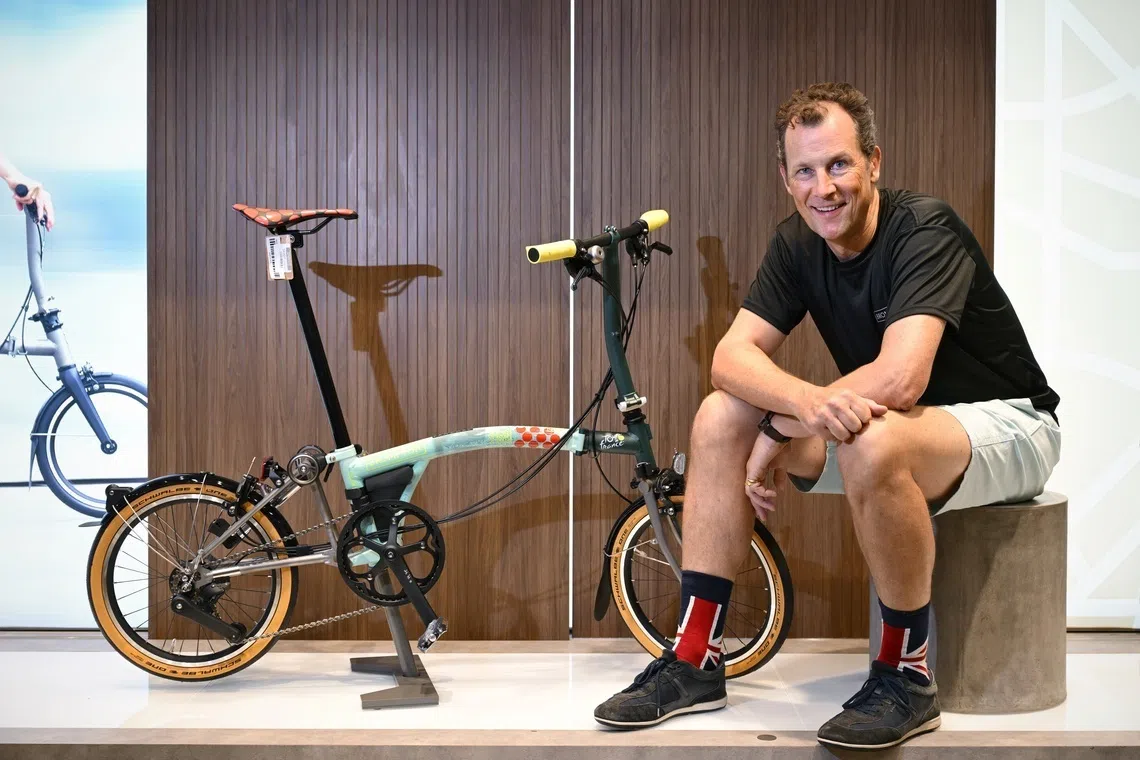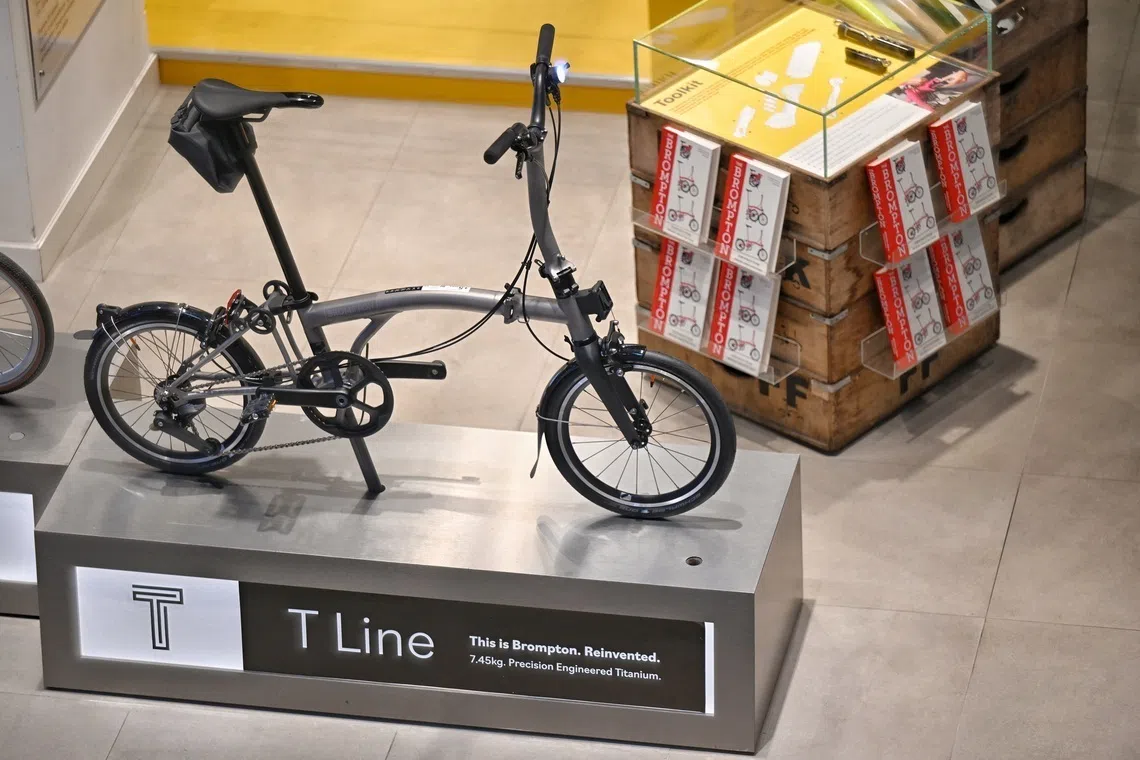Brompton wants you to ride for yourself, and planet Earth
The manufacturing process is designed to cut waste at every stage, and its bicycle rims are mostly made from recycled aluminium
MARKS and Spencer, that icon of British middle-class identity, is now substantially owned by US investment firms like BlackRock and Vanguard Group. Car firm Morris Garages, maker of the classic MGB sports car, has passed into the hands of China’s Saic, and Jaguar Land Rover to India’s Tata Group. Even the franchise for the exploits of the quintessentially British secret agent character James Bond now belongs to Amazon.
Nice, then, to talk about an authentic British brand, Brompton Bicycle.
London-based Brompton, which celebrates its 50th anniversary in 2025, likes to think of itself as a company whose purpose is that form must follow function in everything it does. Hence, its bicycles are designed to disappear when you do not need them, and reappear when you do – something you can fold in less than 20 seconds, and carry on to the train or into the office.
The manufacturing process is designed to cut waste at every stage, and its bicycle rims are mostly made from recycled aluminium. Two years ago, it launched Brompton Renewed, a resale platform for refurbished bicycles. On a recent visit to the Brompton outlet in Funan Mall, I spotted a mechanic servicing a two-decade-old bike.
When I suggest to chief executive officer and co-owner Will Butler-Adams that Brompton seems to think of itself as the Patagonia of the bicycle world, with its emphasis on environmental activism and extreme durability, I get a beam of approval in response.
“We are living in paradise, and if we do not grasp that and make the best of our little moment on planet Earth, what a waste it would be,” he says.
BT in your inbox
Start and end each day with the latest news stories and analyses delivered straight to your inbox.
It is that attitude that has helped the 51-year-old engineer, who confessed that he failed to get into his father’s school, Eton, and had to go to Rugby School, which was still selective but not as prestigious, steer through an industry downturn, following a period of high demand during the Covid-19 pandemic. That was when Brompton could hardly make enough bikes to meet the needs of people who sought mobility, fun and exercise with minimum risk of infections.
But after years of compound growth, Brompton struggled to make money in fiscal 2024, and the current year does not look much better either. At its peak during Covid-19, it made approximately £129 million (S$223.8 million) in the year ending Mar 31, 2023.
Still, he says he would not worry too much about a year or two of downturn for a firm that has made more than a million bicycles since its inception, and grown revenue at a compounded pace. The true measure of Brompton’s success, according to Butler-Adams, is not its Ebitda (earnings before interest, taxes, depreciation and amortisation) but whether it has contributed to urban freedom and helped change how people live in cities.
Brompton is debt-free and has ample cash reserves to ride the growth slowdown, putting it in pa osition to invest through the downturn. And he is confident that the growing awareness of the importance of promoting active lifestyles will feed demand for years to come.
“The cost to governments in ill-health is too expensive. This is why London is investing in cycle lanes and Singapore in the park connector. The UK’s National Health Service is facing a health crisis coming down the track that is so colossal that there isn’t enough money to pay for it,” he says.
“Urban lifestyles cannot be just about getting out of bed, getting into the car or the train and sitting at a desk because the cost of maintaining that culture is just too great.”
Brompton has just launched the G Line of bikes, a product it spent five years developing to allow Brompton owners to go further and explore off-road. Launched in Germany with both pedal and electric versions of the bike, Butler-Adams says the company is having difficulty keeping up with demand.
Why was it not launched in Asia, too? After all, he is big on the company’s prospects in China, where, he says, the investments that nation has made in infrastructure have been terrific news for his sector.
Innovation comes with risk, he explains. Brompton spent nearly £9 million on developing the G Line, half of it on the pedal version and the other half on the electric motor version. The company went through some 260 prototypes before it was confident it had the right product.
“(Still), when you launch a new product, there will be problems – anyone who says there will not be, is talking guff. So, you want your teething troubles to take place close to home before you start shipping it halfway around the world. There is something called the ‘bathtub effect’ when you launch and gain enormous insight in the first months, then it stabilises, and then you hit problems as you approach the end of (product) life. To be honest, the launch in Germany has gone pretty well.”

The electric G Line with a roller frame retails for about 4,000 euros (S$6,050) in Germany. A Brompton “roller frame” or “roller rack” is a kit that adds two small wheels to the rear of a Brompton bicycle, allowing the user to roll the folded bike like a suitcase.
Butler-Adams, who joined Brompton in 2002, calls the G Line the most radical product the company has created, and a significant advance from the Brompton Electric launched in 2017.
After being a metal-basher for decades, getting into electronic motors and software was, he says, a baptism of fire. Brompton worked with the Williams F1 team to develop the electric bike, getting enormous help from its engineering chief Patrick Head, and also helped by a British government grant.
Subsequently, Brompton developed the T Line, a titanium-based bike. After working initially with technically capable but commercially incompetent Russian engineers, and nearly partnering with a British company which turned out to be simply importing frames from China, a chance meeting between him and an engineer who was making titanium-based engine cowlings for Rolls-Royce turned out to be fortuitous.

Today, Brompton’s joint venture with CW Fletcher, a privately owned precision engineering company, has emerged as the largest maker of titanium frames in Europe.
Founded in 1975 by an engineer named Andrew Ritchie and his Cambridge mates – he retains about 15 per cent stock while Butler-Adams owns about 10 per cent of the company – Brompton has 775 employees, who turn out about 2,000 bikes a week on average. Production moves a tad quicker in the summer months and a little more slowly in the cold season when fewer people seek the outdoors.
The CEO sees the company clocking sales of about £140 million in the year to March 2026. Brompton should have no difficulty getting to sales of £500 million over the next few years, he adds.
During the Covid-19 peak, it sold just short of 100,000 bikes, and the manufacturing facilities are scalable over a few months to produce about 200,000 bikes if necessary. The market opportunity, estimates an optimistic Butler-Adams, is 3.5 billion potential customers.
The challenge for Brompton is to turn curiosity about the bike into a willingness to try it. Once that leap of faith is made, he says, customers turn back and say they wish they had done it long ago.
What is he seeing in consumer trends, particularly in China, Asia’s biggest market?
There are interesting shifts in consumer behaviour taking shape, he says. No longer are the young chasing the exhibitionism inherent in purchasing the latest luxury bag or clothing item. Instead, they seek fulfilment in experience – a lifestyle that makes them feel good, and they can share on social media.
“The young Chinese are prouder of their experiences than of the products. They are more confident about deciding what they want, rather than blindly following others.”
So, young Chinese are into running, into paddling, into camping, and cycling. And Brompton, he says, is in the foothills of that mountain of demand.
A Brompton may look simple and uncomplicated, but it is apparently made up of close to 1,200 parts. Ordinarily, and in these days of global supply chain challenges, that should be something of a headache. But like a Moser watch, with most of its components made in-house, including the hairsprings and balance wheels, Brompton makes the majority of its parts itself.
“Most of the parts – about 70 per cent – are unique to us, designed specially for our weird and slightly peculiar bike,” he says. “We do not really buy from the bike industry.”
Still, Brompton did suffer a shortage of sensors – sourced from outside the company – in 2021, because the drone industry was sucking up all the sensors available. That issue, says Butler-Adams, has been resolved.
When he entered the business back in 2002, Brompton bikes used to weigh 12.5kg. Today, their weight is down to 7.5kg, and I ask if it can be reduced even more as materials science advances.
Not all bikes, he says. While a standard bike can be possibly made lighter, it is less easy with electric bikes because of the motor and so forth. Still, he asserts, the company is into “ludicrously cool” research that should bear fruit in a few years.
Some manufacturers use benchmarking as a strategy; line up the best in the business and match that part for part in your own product. But Brompton shuns benchmarking.
“It depends on what you want,” he says. “If you want to be second best, benchmark. But if you want to be the best, don’t waste your time benchmarking because the best you will ever be is as good as your competition.”
Instead, it scouts for ideas from non-competing industries – oil rigs, aerospace, Formula One racing – to innovate parts and designs.
I asked if there was a code around the Brompton. And there is one.
“Brompton. Everyone’s invited.”
If your parents ran behind you when you were between four and six, hoping you were not going to fall off your bicycle and cut your knee, and waiting for the magic moment when it all clicked into place, that moment is the same in Lagos, Montreal or Xi’an, says Butler-Adams, who carts his T Line Brompton around the world.
“The bicycle is a universal thing. It is the most efficient mode of transportation ever invented. And it is a miracle pill for health. The best Brompton I can see is one beat to bits, because that means it is loved, has given experiences to somebody.” THE STRAITS TIMES


